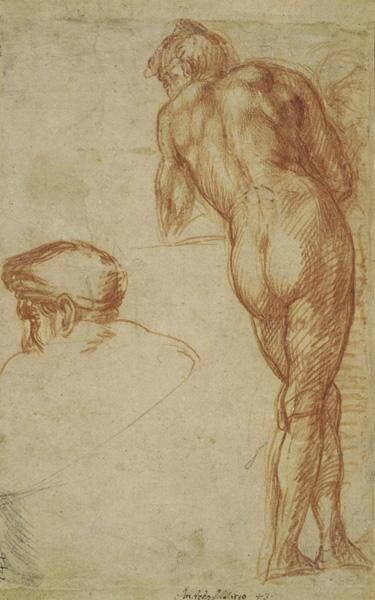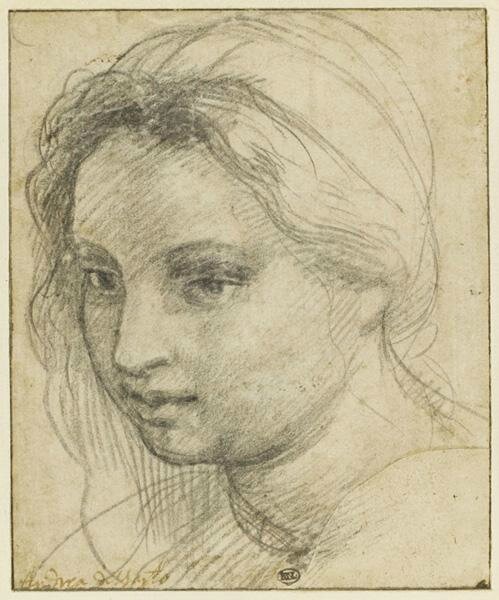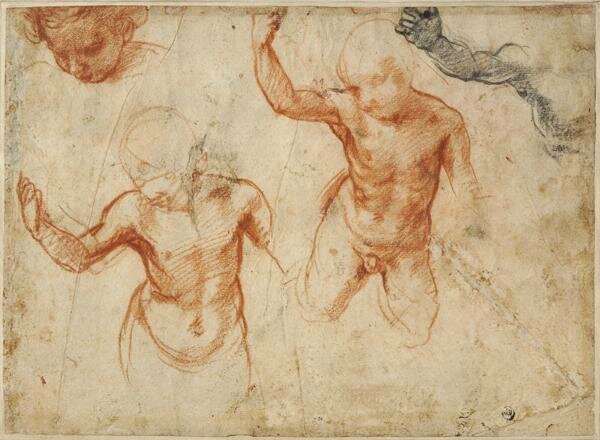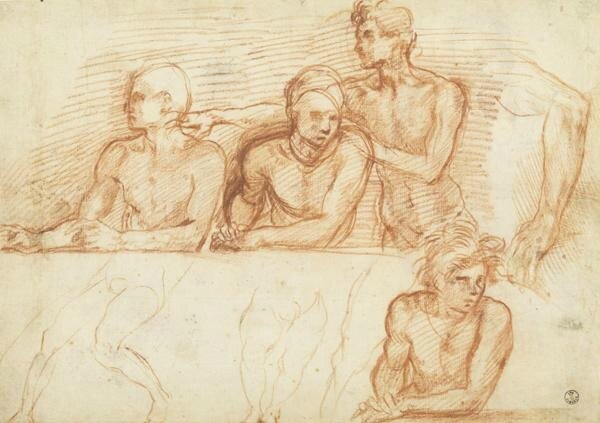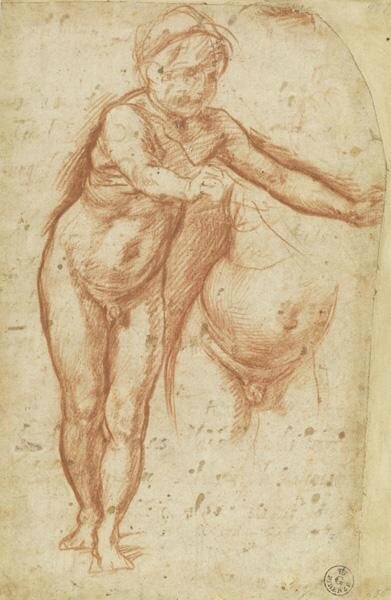First major U.S. monographic exhibition on Andrea del Sarto opens at the Frick Collection
NEW YORK, NY.- Andrea d’Agnolo (1486–1530), called Andrea del Sarto after his father’s profession as a tailor (sarto), transformed sixteenth-century Florence through his art and influence. Through his large and prolific workshop, one of the most significant of the age, he enriched his native city with portraits, altarpieces, and fresco paintings. Drawings were at the core of his working process. Produced primarily in red and black chalks, his vibrant figure studies, energetic compositional drawings, and masterful head studies display the range of his talents as a draftsman and the complex roles that drawing played in developing his paintings. This autumn, The Frick Collection celebrates the Italian master with Andrea del Sarto: The Renaissance Workshop in Action, the first major U.S. monographic exhibition devoted to his art, centering on his creative process. This exhibition was organized with the J. Paul Getty Museum, Los Angeles, where it has run as a summer show. In New York, the presentation will feature forty-five drawings and three paintings from international collections and will offer an unprecedented look inside the creative production of one of the most influential figures in Italian Renaissance art. To be shown in the Oval Room and in the lower-level galleries, the exhibition was coordinated at the Frick by Associate Curator Aimee Ng and is accompanied by a substantial catalogue as well as a series of public programs.
Running almost concurrently with the Frick’s exhibition, The Metropolitan Museum of Art will present a three-painting focused exhibition, Andrea del Sarto’s Borgherini Holy Family, on view October 14, 2015, through January 10, 2016.
A DEFINING ARTIST OF THE RENAISSANCE
Andrea spent the majority of his career in Florence, where he was born in 1486 and died of the plague forty-four years later. According to Giorgio Vasari, his former pupil and the author of the Lives of the Artists, he trained first under a goldsmith, then with artist Andrea di Salvi Barile before moving on to the studio of Piero di Cosimo, who was well known for his imaginative and eccentric style. By 1510, Andrea was practicing as an independent master, executing fresco paintings at major public sites. His workshop became the most highly esteemed in Florence, attracting talented young artists including Jacopo Pontormo, Rosso Fiorentino, and Vasari.
The artist was a contemporary of Leonardo da Vinci, Raphael, and Michelangelo, and a number of sixteenth-century texts name him among the defining artists of the Renaissance. In subsequent centuries, however, his status and the popularity of his art waned. This decline may be attributed in part to the somewhat derisive biography written by Vasari. While praising Andrea’s work as “senza errori (without errors),” Vasari also criticizes him as weak, lacking boldness in his person and art. He even suggests that Andrea would have surpassed Raphael in his accomplishments had it not been for Andrea’s excessive love for his wife, which, Vasari claims, led to missed opportunities and caused him to use her features repeatedly in his art (a practice Vasari frowned on). Although recent documentary investigation of Andrea and his family has proven Vasari’s characterization inaccurate, it persisted for centuries.
HE ROLE OF DRAWINGS IN DEL SARTO’S WORKSHOP
Almost two hundred drawings by Andrea are known today. While it is notoriously difficult to reconstruct the inner workings of a Renaissance studio—the delegation of labor, specifics of training, and involvement of the master—it is certain that, in Andrea’s as in others, assistants relied on the master’s designs when executing painting projects. Drawings were therefore the heart of the workshop. The forty-five autograph drawings included in the Frick’s exhibition span the entirety of Andrea’s career. Compositional sheets, figural studies, and detailed drawings of heads, hands, and other body parts trace the creative process of the artist as he moved from paper to canvas or panel and back again. It was also not uncommon for him to reuse drawings for more than one project. Andrea’s drawings reveal his analytic and imaginative strengths and show his experimental approach to chalk as a medium, exploiting the effects of wetting the tip before applying it to paper, going over a broad area of chalk with a wet brush, stumping (rubbing with an instrument), and combining black and red chalks on the same sheet.
The exquisite Study for the Head of Julius Caesar is an example of his most refined application of chalk. Combining hatching and rubbing, possibly using the wetted tip of a sharpened piece of chalk, the artist marshals the medium to create nuances of light and shade and expressive contours, establishing the virility and strength of the figure through an elegant classical profile. The drawing prepares the head of Julius Caesar in Andrea’s monumental fresco Tribute to Caesar at the Villa Medici in Poggio a Caiano, and its highly finished state attests to the enormous amount of preparation that Andrea invested in the painting, which includes more than two dozen figures. Several additional preparatory sheets for this project survive (two others are in the exhibition) and show the range of drawings, from rough to highly finished, which he employed to achieve his final production.
Andrea del Sarto (1486–1530), Study for the Head of Julius Caesar, ca. 1520. Red chalk, 8 7/16 x 7 1/4 in. (21.5 x 18.4 cm). The Metropolitan Museum of Art; Partial and Promised Gift of Mr. and Mrs. David M. Tobey, 2008 © The Metropolitan Museum of Art, courtesy Art Resource, NY
RARE COMPOSITIONAL STUDIES INCLUDED
In comparison to figural studies, relatively few of Andrea’s compositional sheets survive. These drawings, which map the placement of figures in space, document him thinking through the challenges of pictorial storytelling. The Composition Study for the Birth of Saint John the Baptist prepares a fresco in Florence’s Chiostro dello Scalzo, which takes its name from the ritualistic barefoot (“scalzo”) processions of the resident brotherhood of St. John the Baptist. Considered one of the major narrative fresco cycles of the Renaissance in Florence, the decorative program and twelve scenes for this commission illustrating the life of the saint engaged Andrea off and on for about fifteen years, probably between 1510 and 1526. This sheet, the only compositional study related to the cycle known to survive, depicts the episode described in Luke 1:59–64, in which the newborn’s father, Zacharias, who had been struck mute for his disbelief, names his son. Unable to speak, he writes on a tablet “His name is John,” the name decreed to him by the angel Gabriel, and immediately regains his voice. Exploring the possibilities of achieving narrative legibility through graceful and varied forms, Andrea altered many aspects of the drawn composition in the painting. Most obviously, in the fresco he has swathed the long, slender bodies in drapery, following the Renaissance convention of depicting figures nude (or partially nude) in preparatory sketches. The figures’ interactions have also been modified in minute but powerful ways: for example, while in the drawing Elizabeth (in bed) faces the nurse in order to receive her son, in the fresco she turns to address the miraculous event of his naming.
Andrea del Sarto (1486–1530), Studies of a Head and a Hand, 1510. Red chalk, 5 9/16 x 8 1/16 in. (14.2 x 20.5 cm). The Metropolitan Museum of Art; Rogers Fund, 1996 © The Metropolitan Museum of Art, courtesy Art Resource, NY
Andrea del Sarto (1486–1530), Head of Leonardo di Lorenzo Morelli, 1512. Black chalk, 12 3/8 x 9 5/8 in. (31.5 x 24.5 cm), Recto. Fondation Custodia, Collection Frits Lugt, Paris.
Andrea del Sarto (1486–1530), Study of a Standing Young Man Holding a Book, ca. 1515. Black chalk, 14 5/8 x 6 3/8 in. (37.1 x 16.2 cm). Staatliche Museen zu Berlin, Kupferstichkabinett bpk, Berlin / Kupferstichkabinett, Staatliche Museen, Berlin, Germany / Photo: Volker-H. Schneider / Art Resource, NY
Andrea del Sarto (1486–1530), Head of a Young Woman, ca. 1517. Black chalk, 10 1/8 x 8 1/16 in. (25.7 x 20.5 cm). Fondation Custodia, Collection Frits Lugt, Paris.
Andrea del Sarto (1486–1530), Drapery Study, ca. 1517. Red chalk, 11 x 6 in. (27.9 x 15.2 cm). Recto. The J. Paul Getty Museum, Los Angeles.
Andrea del Sarto (1486–1530), Study of the Head of an Old Man in Profile, ca. 1520. Red chalk, 9 7/16 x 10 7/8 in. (23.9 x 27.7 cm). Recto. Staatliche Museen zu Berlin, Kupferstichkabinett.
Andrea del Sarto (1486–1530), Study of a Nude Man Seen from Behind, Leaning on a Surface, and a Separate Study of His Head, ca. 1520. Red chalk, with some black chalk, 11 x 6 15/16 in. (27.9 x 17.7 cm), Recto . The British Museum; bequeathed by William Fawkener, 1769. © The Trustees of the British Museum
Andrea del Sarto (1486–1530), Studies of Children and of a Left Hand, 1522–26. Red chalk, 7 13/16 x 9 3/4 in. (19.8 x 24.7 cm). The British Museum; bequeathed by William Fawkener, 1769. Recto © The Trustees of the British Museum
Andrea del Sarto (1486–1530), Study of a Kneeling Figure with a Sketch of a Face, 1522–26. Red and black chalk, 11 7/8 x 7 13/16 in. (30.1 x 19.8 cm). Recto. The J. Paul Getty Museum, Los Angeles.
Andrea del Sarto (1486–1530), A Skull and Thigh Bone, 1522–26. Red chalk, 7 13/16 x 9 3/4 in. (19.8 x 24.7 cm). The British Museum; bequeathed by William Fawkener, 1769. Verso © The Trustees of the British Museum
Andrea del Sarto (1486–1530), Studies of Children, 1522–26. Red and black chalk, 7 7/8 x 9 13/16 in. (20 x 25 cm). The British Museum; bequeathed by George Salting, 1910 © The Trustees of the British Museum
Andrea del Sarto (1486–1530), Study of the Head of a Young Woman, ca. 1523. Red chalk, 8 9/16 x 6 11/16 in. (21.7 x 17 cm). Galleria degli Uffizi, Gabinetto Disegni e Stampe, Florence. Courtesy the Ministero dei beni e delle attività culturali e del turismo
Andrea del Sarto (1486–1530), Study of the Head of a Woman, ca. 1525. Black chalk, 5 3/16 x 4 5/16 in. (13.2 x 10.9 cm). Musée du Louvre, Paris, Département des Arts Graphiques © RMN-Grand Palais / Art Resource, NY. Photo: Stephane Marechalle.
Andrea del Sarto (1486–1530), Study of the Head of a Child Looking to the Right, ca. 1525. Black chalk, 7 3/4 x 7 3/8 in. (19.7 x 18.7 cm). Galleria degli Uffizi, Gabinetto Disegni e Stampe, Florence. Courtesy the Ministero dei beni e delle attività culturali e del turismo
Andrea del Sarto (1486–1530), Studies of a Child, 1522–26. Red and black chalk, 7 5/8 x 10 7/16 in. (19.3 x 26.5 cm). Recto. Fondation Custodia, Collection Frits Lugt, Paris.
Andrea del Sarto (1486–1530), Study for the Head of St. Joseph, ca. 1526–27. Red and black chalk, 14 11/16 x 8 11/16 in. (37.3 x 22 cm). Private Collection.
Andrea del Sarto (1486–1530), Study of a Bearded Man in Profile, ca. 1526–27. Black chalk, possibly with gray wash, 8 9/16 x 7 1/8 in. (21.8 x 18.1 cm). Galleria degli Uffizi, Gabinetto Disegni e Stampe, Florence. Courtesy the Ministero dei beni e delle attività culturali e del turismo
Andrea del Sarto (1486–1530), Study of the Arm of a Figure Seated in Profile to the Right, ca. 1526–27. Red chalk, 7 9/16 x 8 1/4 in. (19.2 x 20.9 cm). Galleria degli Uffizi, Gabinetto Disegni e Stampe, Florence. Courtesy the Ministero dei beni e delle attività culturali e del turismo
Andrea del Sarto (1486–1530), Head of a Man Looking Up, ca. 1527. Black chalk, with later red chalk additions, 9 3/4 x 6 15/16 in. (24.7 x 17.7 cm). The Ashmolean Museum, Oxford; purchased, 1944 © Ashmolean Museum, University of Oxford.
Andrea del Sarto (1486–1530), Studies of Hands, ca. 1527. Red chalk, 4 13/16 x 6 7/16 in. (12.2 x 16.3 cm). The Metropolitan Museum of Art; bequest of Walter C. Baker, 1971 © The Metropolitan Museum of Art, courtesy Art Resource, NY
Andrea del Sarto (1486–1530), Head of an Infant in Profile to the Right, ca. 1527. Red chalk, 9 3/4 x 7 in. (24.7 x 17.8 cm), Recto. Galleria degli Uffizi, Gabinetto Disegni e Stampe, Florence. Courtesy the Ministero dei beni e delle attività culturali e del turismo
Andrea del Sarto (1486–1530), Studies of Figures Seated and Standing Behind a Table, ca. 1526–27. Red chalk, 10 1/16 x 14 5/16 in. (25.6 x 36.3 cm), Recto. Galleria degli Uffizi, Gabinetto Disegni e Stampe, Florence.
Courtesy the Ministero dei beni e delle attività culturali e del turismo
Andrea del Sarto (1486–1530), Studies after the Laocoön, ca. 1528. Red chalk, 11 1/8 x 8 9/16 in. (28.3 x 21.7 cm). Galleria degli Uffizi, Gabinetto Disegni e Stampe, Florence. Courtesy the Ministero dei beni e delle attività culturali e del turismo
Andrea del Sarto (1486–1530), Study of a Donkey in Profile to the Left, Grazing, ca. 1528. Red chalk, 6 5/8 x 7 5/8 in. (16.9 x 19.3 cm). The British Museum; bequeathed by William Fawkener, 1769 © The Trustees of the British Museum
VIBRANT FIGURAL STUDIES
The Birth of the Baptist compositional study was certainly accompanied by now-lost drawings studying individual figures, similar to that of the Study of a Kneeling Figure, which was produced in preparation for the altarpiece known as the Panciatichi Assumption (Palazzo Pitti, Florence). This vibrant sheet offers a view inside Andrea’s workshop, in which his studio assistants, called garzoni, often served as ready models.
Like the figures in the Composition Study for the Birth of Saint John the Baptist, this figure (which becomes an apostle in the altarpiece) is drawn unclothed despite its being a study for a heavily draped figure. Careful articulation of musculature reveals Andrea’s power of observation and suggests that he sought to understand the anatomical mechanics of a pose even if the final figure was to be clothed. At the same time, he is selective in his focus: here, he concentrates on the back, buttocks, and right arm and leg, leaving the left hand, feet, and face unarticulated. By capturing live models in this way, he activates his paintings, infusing his sacred and secular dramas with a deeply human character.
If the Study of a Kneeling Figure neglects hands and feet, other sheets make them their sole focus. With meticulous attention to the folds, bulges, and pull of skin over bone, Studies of Hands with its masterful play of highlight, shadow, and reflected light, evokes Vasari’s praise of Andrea as a pittore senza errori, a faultless painter. Here he depicts what are most likely the hands of a saint, with a book in one hand and an unidentifiable attribute in the other. Although its connection to a painting has not been firmly established (perhaps because the project it prepared was destroyed or abandoned before completion), the drawing must have been valued within the workshop as an exemplary study of human hands, as evidenced by the very fact of its survival.
Andrea’s most arresting graphic expressions are his head studies, which seem to probe beyond the physical body to its emotional core. Much more than presenting likeness, Andrea’s head studies explore the expressiveness of the human face in sometimes breathtaking complexity. In the Study for the Head of Saint John the Baptist, for example, Andrea endows the face of his model with a combination of youthfulness and gravity. One wonders about the identity of this adolescent, whose disheveled hair the artist renders playfully and whose cleft chin was so carefully observed. The boy’s askance look and slightly furrowed brow seem to betray the selfconsciousness of one instructed to pose for an artist who visually devours his features.
Andrea del Sarto (1486–1530), The Adoration of the Magi, ca. 1511. Red chalk, 14 7/16 x 12 3/16 in. (36.6 x 30.9 cm). Galleria degli Uffizi, Gabinetto Disegni e Stampe, Florence. Courtesy the Ministero dei beni e delle attività culturali e del turismo
Andrea del Sarto (1486–1530), Study of a Woman, ca. 1517–25. Red chalk, 9 1/2 x 7 15/16 in. (24.2 x 20.1 cm), Recto. Galleria degli Uffizi, Gabinetto Disegni e Stampe, Florence. Courtesy the Ministero dei beni e delle attività culturali e del turismo
Andrea del Sarto (1486–1530), The Madonna and Child with St. John, ca. 1516–17. Red chalk 12 3/8 x 9 3/16 in. (31.5 x 23.3 cm). Galleria degli Uffizi, Gabinetto Disegni e Stampe, Florence. Courtesy the Ministero dei beni e delle attività culturali e del turismo
Andrea del Sarto (1486–1530), Studies of the Head of an Infant, ca. 1522. Red chalk, 9 3/4 x 7 1/4 in. (24.8 x 18.4 cm), Recto. Galleria degli Uffizi, Gabinetto Disegni e Stampe, Florence. Courtesy the Ministero dei beni e delle attività culturali e del turismo
Andrea del Sarto (1486–1530), Drapery Study, ca. 1522. Black chalk, 6 1/2 x 6 3/8 in. (16.5 x 16.2 cm), Recto. Galleria degli Uffizi, Gabinetto Disegni e Stampe, Florence. Courtesy the Ministero dei beni e delle attività culturali e del turismo
Andrea del Sarto (1486–1530), Study of a Child with Arms Extended, ca. 1522. Red chalk, 9 13/16 x 6 5/16 in. (25 x 16.1 cm). Galleria degli Uffizi, Gabinetto Disegni e Stampe, Florence. Courtesy the Ministero dei beni e delle attività culturali e del turismo

/https%3A%2F%2Fprofilepics.canalblog.com%2Fprofilepics%2F1%2F0%2F100183.jpg)
/https%3A%2F%2Fstorage.canalblog.com%2F03%2F02%2F119589%2F96711876_o.jpg)
/https%3A%2F%2Fstorage.canalblog.com%2F11%2F31%2F119589%2F94773502_o.jpg)
/https%3A%2F%2Fstorage.canalblog.com%2F20%2F83%2F119589%2F94772815_o.jpg)
/https%3A%2F%2Fstorage.canalblog.com%2F26%2F72%2F119589%2F75604929_o.jpg)
/https%3A%2F%2Fstorage.canalblog.com%2F59%2F60%2F119589%2F26458628_o.jpg)








